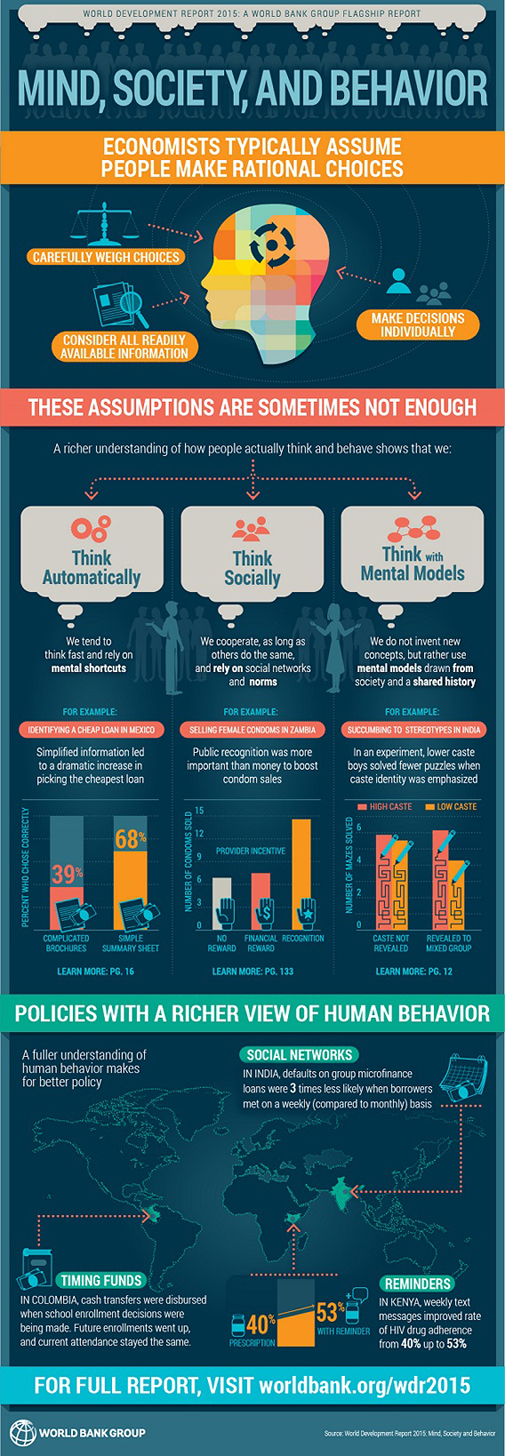World Development Report (2015)
by 趙永祥 2017-05-07 11:29:33, 回應(0), 人氣(908)
2017-05-07 11:29:33, 回應(0), 人氣(908)
The trends of Mind,Society and Behavior

http://www.worldbank.org/en/publication/wdr2015

Summary on this Hot Issue
Every policy makes assumptions about human
behavior.
Public policy typically subsidizes and publicizes
activities worth encouraging and taxes those
to be discouraged. Underlying this approach is the
notion that human behavior
arises from “rational”
choice: individuals carefully weigh their choices,
consider all readily available information, and make
decisions on their own. Policies arising from
this perspective
focus on changing the benefits and costs of
individual actions, and have proven very effective in
many domains.
In recent decades, however, research on decision
making has cast doubt on the extent to which people
make choices in these ways. Novel policies based on a
more accurate understanding of how people actually
think and behave have shown great promise, especially
for addressing some of the most difficult development
challenges, such as increasing productivity,
breaking the cycle of poverty from one generation to
the next,
and acting on climate change.
Three principles of human decision
making
To understand and apply recent findings on human
decision making, this year’s World Development
Report presents a framework
that relies on three
principles:
1. Thinking automatically.
Much of our thinking is
automatic and based on what comes to mind
effortlessly. Deliberative thinking, in which we
weigh the value of all available choices, is less
common. We use mental shortcuts much of the
time. Thus minor changes in the immediate context in which decisions are made can have disproportionate
effects on behavior.
2. Thinking socially.
Human beings are deeply social.
We like to cooperate—as long as others are doing
their share. Institutions and interventions can be
designed to support cooperative
behavior. Social
networks and social norms can serve as the basis
of new kinds of
policies and interventions.
3. Thinking with mental models.
When people think,
they generally do not invent concepts. Instead,
they use mental models drawn from their societies
and their shared histories. Societies provide
people with multiple and often conflicting mental
models; which one is invoked depends on
contextual cues. Policies and interventions to
activate favorable mental models can make people
better off.
Psychological and social perspectives
on policy
These three principles have major implications for
development policies and interventions. Interventions
need to take into account the specific psychological
and social influences that guide decision
making and behavior in a particular setting. That
means that the process of designing and implementing
effective interventions needs to become a more
iterative process of discovery, learning, and adaptation.
What matters is not only which policy to implement,
but also how it is implemented.
In addition, experts, policy makers, and development
professionals must recognize that they, too,
are subject to social and cultural influences, and think automatically.
They tend to select and filter
evidence in ways that confirm their prior views.
Their social contexts can lead them to misunderstand
how people living in poverty make decisions
and behave. They need to become aware of their
own biases, and development organizations should
implement procedures to mitigate the adverse effects
of these biases.
Seen under a psychological and social lens, poverty
is more than a deprivation in material resources.
The stresses and strains of poverty impose “taxes” on
cognitive resources.
Policy makers should try to move
crucial decisions out of time periods when mental resources
are especially scarce.
They can, for example,
shift school enrollment decisions to periods when
poor farmers’ seasonal income is higher. They can
also target assistance to important decisions that
require a lot of cognitive resources, such as applying
to a higher education program.
These ideas apply to
any initiative in which program take-up is a challenge.
Poverty early in life also affects psychological resources.
High stress and insufficient socio-emotional
and cognitive stimulation in the earliest years can
impair cognitive development.
Programs that provide
very early childhood stimulation can have a
large impact on adult success.
Adopting a psychological and social perspective
enlarges policy makers’ toolkits. For example, simplifying
decisions can help people make choices that
better serve their interests. Enrolling in government
programs is often too difficult, and household finance
decisions require considerable cognitive resources.
It is easier for consumers to determine which
loans and savings products are best when they are
presented with succinct summaries of savings rates
and loan costs.
Financial literacy programs are more
effective when they teach rules of thumb instead
of a
standard financial education module.
Using reminders is another new tool to help individuals
execute their plans. Weekly text message
reminders can help patients take their medicine
regularly. Reminders about late fees on loans improve timely repayment. But reminders need to be appropriately
tailored; those that cite specific reasons for
saving can be twice as effective as generic messages.
Commitment devices can help people act
on their
intentions by locking them into a course of action,
such as eating more healthy foods, working harder,
or saving more.
In many cases, around one-third of
individuals who are offered commitment devices
(often in the form of fees or financial penalties for
failing to meet their own goals)
accept them.
Social incentives can be as effective as economic
ones. Informing people how much energy they consume
compared to their neighbors reduces average
consumption. Publicly praising people who conserve
water and reproaching those
who do not can help a
city avert a water supply crisis because people tend to
conserve more when they have assurance that others
will also conserve.
Social awards, gifts, non-monetary
prizes, and recognition can lead people to work
harder. Many programs are more effective when they
are channeled through peers and networks, rather
than through the individual alone.
Entertaining educational narratives can drive key
development choices. Television and radio shows
that incorporate social messages can reduce teenage
pregnancy, improve savings rates, and increase women’s
autonomy.
Aspirational messages can increase
parents’ investments in their children’s education
and school performance.
